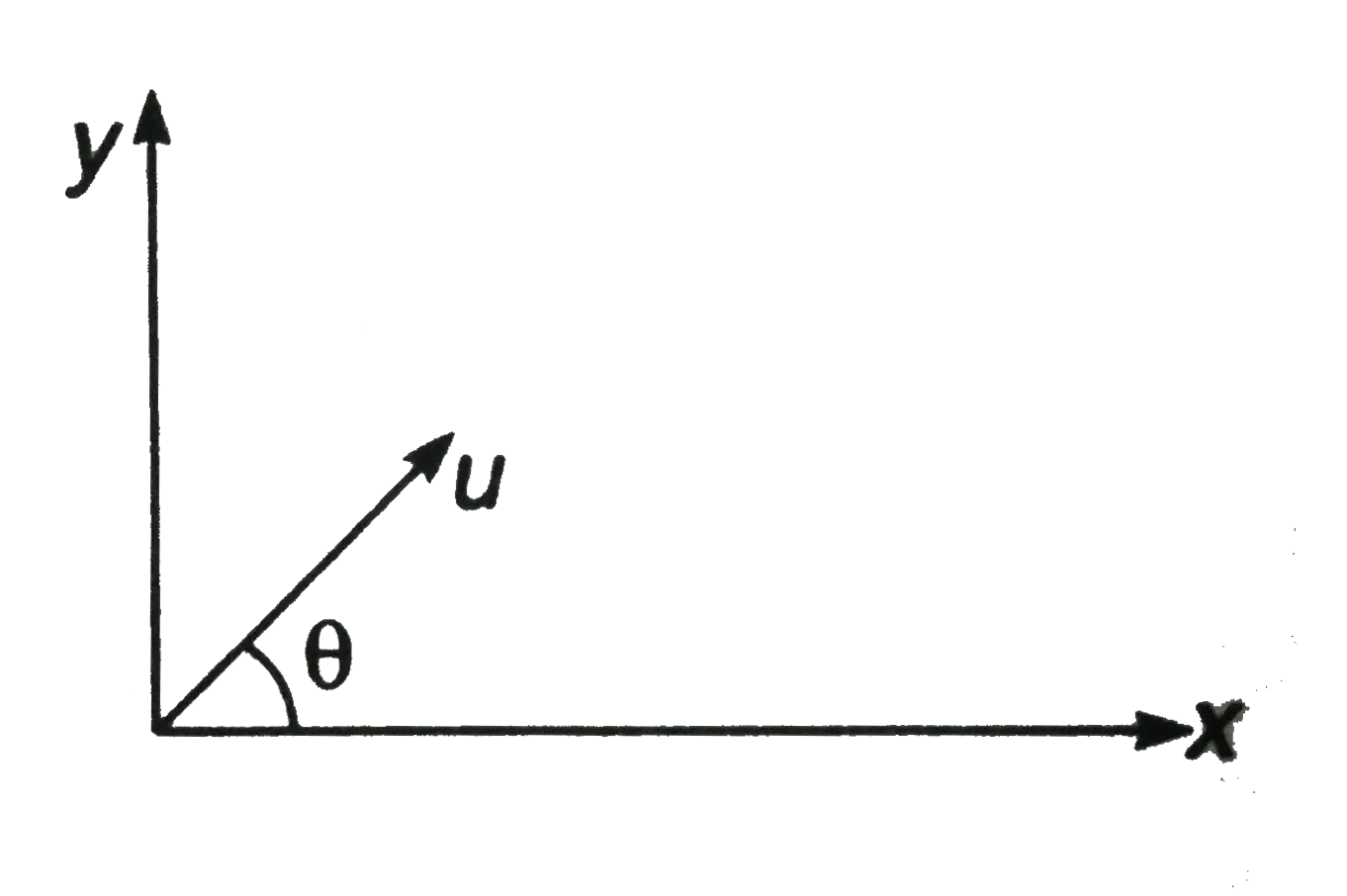A particle is projected from ground at angle 45∘ with initial velocity 20(√2)m/s. Find
(a) change in velocity,
(b) magnitude of average velocity in a time interval from t=0 to t=3s.
The correct Answer is:A, B, C, D
To solve the problem step by step, let's break it down into two parts: (a) finding the change in velocity and (b) finding the magnitude of average velocity over the time interval from t=0 to t=3 seconds.
1. Determine the initial velocity components:
The initial velocity u is given as 20√2m/s at an angle of 45∘.
- The horizontal component ux=ucos(45∘)=20√2⋅1√2=20m/s.
- The vertical component uy=usin(45∘)=20√2⋅1√2=20m/s.
Thus, the initial velocity vector is:
u=20^i+20^jm/s
2. Calculate the final velocity after 3 seconds:
The acceleration due to gravity a is −10m/s2 (acting downwards).
- The final velocity in the horizontal direction remains unchanged: vx=ux=20m/s.
- The final velocity in the vertical direction is given by:
vy=uy+at=20+(−10)(3)=20−30=−10m/s
Thus, the final velocity vector is:
v=20^i−10^jm/s
3. Calculate the change in velocity:
The change in velocity Δv is given by:
Δv=v−u=(20^i−10^j)−(20^i+20^j)=0^i−30^j=−30^jm/s
Part (b): Magnitude of Average Velocity
1. Calculate the displacement during the time interval:
The displacement s can be calculated using the formula:
s=ut+12at2
where a=0^i−10^jm/s2.
- The displacement in the horizontal direction:
sx=uxt=20⋅3=60m
- The displacement in the vertical direction:
sy=uyt+12ayt2=20⋅3+12(−10)(32)=60−45=15m
Thus, the displacement vector is:
s=60^i+15^jm
2. Calculate the average velocity:
The average velocity vavg is given by:
vavg=Δst=60^i+15^j3=20^i+5^jm/s
3. Find the magnitude of the average velocity:
The magnitude of vavg is calculated as:
|vavg|=√(20)2+(5)2=√400+25=√425≈20.62m/s
Final Answers
(a) Change in velocity: −30^jm/s
(b) Magnitude of average velocity: ≈20.62m/s
The initial velocity u is given as 20√2m/s at an angle of 45∘.
- The horizontal component ux=ucos(45∘)=20√2⋅1√2=20m/s.
- The vertical component uy=usin(45∘)=20√2⋅1√2=20m/s.
u=20^i+20^jm/s
The acceleration due to gravity a is −10m/s2 (acting downwards).
- The final velocity in the horizontal direction remains unchanged: vx=ux=20m/s.
- The final velocity in the vertical direction is given by:
vy=uy+at=20+(−10)(3)=20−30=−10m/s
v=20^i−10^jm/s
The change in velocity Δv is given by:
Δv=v−u=(20^i−10^j)−(20^i+20^j)=0^i−30^j=−30^jm/s
The displacement s can be calculated using the formula:
s=ut+12at2
where a=0^i−10^jm/s2.
- The displacement in the horizontal direction:
sx=uxt=20⋅3=60m
- The displacement in the vertical direction:
sy=uyt+12ayt2=20⋅3+12(−10)(32)=60−45=15m
s=60^i+15^jm
The average velocity vavg is given by:
vavg=Δst=60^i+15^j3=20^i+5^jm/s
The magnitude of vavg is calculated as:
|vavg|=√(20)2+(5)2=√400+25=√425≈20.62m/s
(a) Change in velocity: −30^jm/s
(b) Magnitude of average velocity: ≈20.62m/s
Topper's Solved these Questions
- PROJECTILE MOTIONBOOK - DC PANDEY ENGLISHCHAPTER - PROJECTILE MOTIONEXERCISE - Exercise 7.3
6 Videos
- PROJECTILE MOTIONBOOK - DC PANDEY ENGLISHCHAPTER - PROJECTILE MOTIONEXERCISE - Level - 1 Assertion And Reason
10 Videos
- PROJECTILE MOTIONBOOK - DC PANDEY ENGLISHCHAPTER - PROJECTILE MOTIONEXERCISE - Exercise 7.1
5 Videos
- MOTION IN A PLANEBOOK - DC PANDEY ENGLISHCHAPTER - MOTION IN A PLANEEXERCISE - (C )Medical entrances gallery
32 Videos
- PROPERTIES OF MATTERBOOK - DC PANDEY ENGLISHCHAPTER - PROPERTIES OF MATTEREXERCISE - Integer
8 Videos
Similar Questions
A particle is projected from ground with velocity 40√2m/s at 45∘. At time t=2s
View SolutionA particle is projected from ground with initial velocity u=20(√2)m/s at θ=45∘. Find
(a) R,H and T,
(b) velocity of particle after 1 s
(c) velocity of particle at the time of collision with the ground (x-axis).

View SolutionA particle is projected from ground with velocity 40(√2)m/s at 45∘. Find
(a) velocity and
(b) displacement of the particle after 2 s. (g=10m/s2)
View SolutionA particle is projected from ground with speed 80 m/s at an angle 30∘ with horizontal from ground. The magnitude of average velocity of particle in time interval t = 2 s to t = 6 s is [Take g = 10 m/s2]
View SolutionA particle is projected from ground with velocity 3ˆi+4ˆj m/s. Find range of the projectile :-
View SolutionA particle is projected from ground with velocity 20(√2)m/s at 45∘. At what time particle is at height 15 m from ground? (g=10m/s2)
View SolutionA particle is projected with speed u at angle θ with horizontal from ground . If it is at same height from ground at time t1andt2 , then its average velocity in time interval t1 to t2 is
View SolutionA projectill is projected at an angle (α>45∘) with an initial velocity u. The time t, at which its magnitude of horizontal velocity will equal the magnitude of vertical velocity is :-
View SolutionA particle is projected upwards from the roof of a tower 60 m high with velocity 20m/s. Find
(a) the average speed and
(b) average velocity of the particle upto an instant when it strikes the ground. Take g=10m/s2
View SolutionFrom a point on the ground a particle is projected with initial velocity u, such that its horizontal range is maximum. The magnitude of average velocity during its ascent is
View Solution
